Detailed Description and Morphological Assessment of Sepia typica (Steenstrup, 1875) (Cephalopoda: Sepiidae)
Abstract
:1. Introduction
2. Material and Methods
2.1. Data Collection
2.2. Data Preprocessing
2.3. Data Analysis
3. Results
3.1. Geographic Variation in Meristic Counts
3.2. Geographic Variation in Morphometric Measurements
3.3. Geographic Variation in Male Arm Morphology
4. Discussion
5. Systematic Account





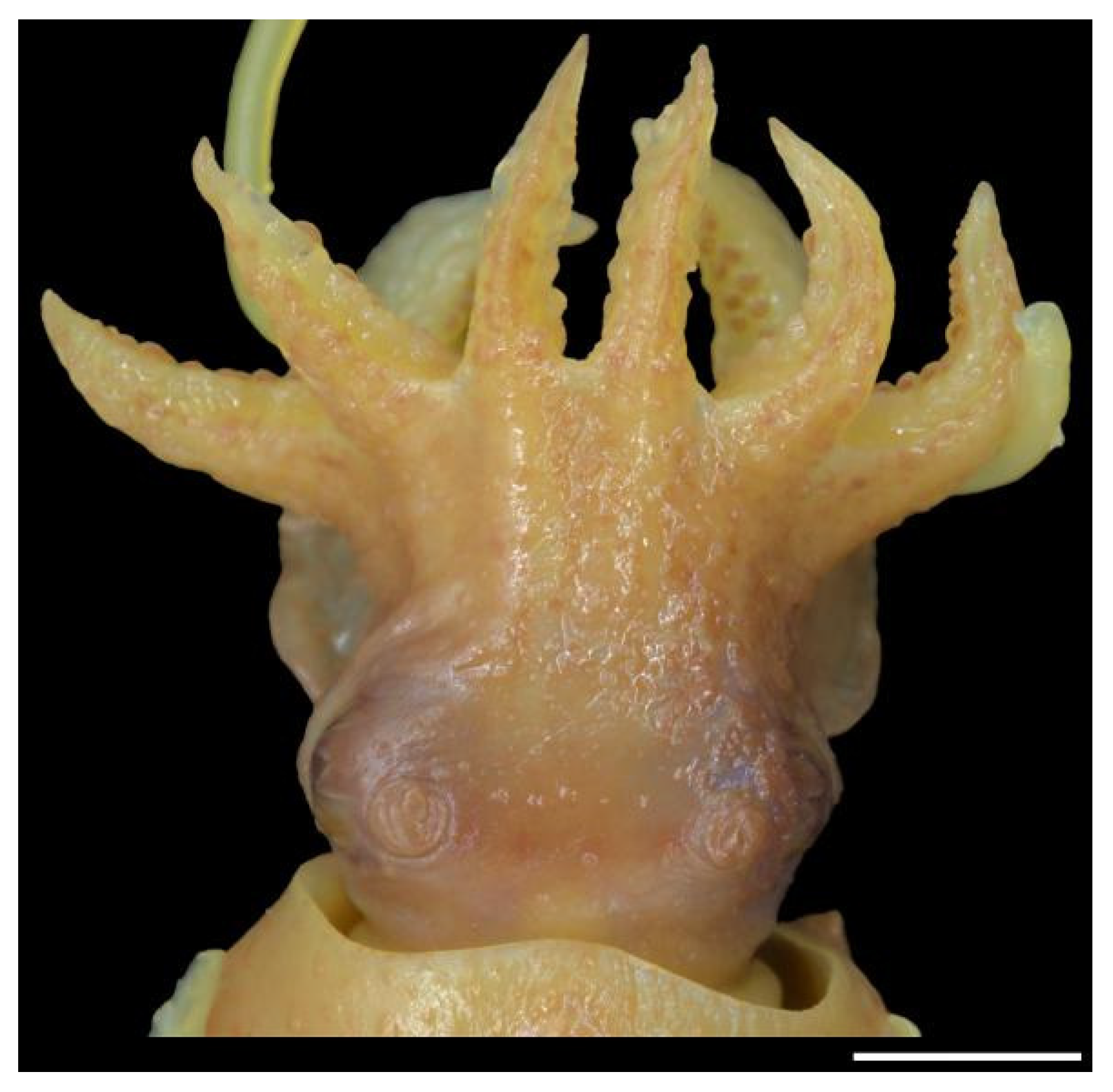
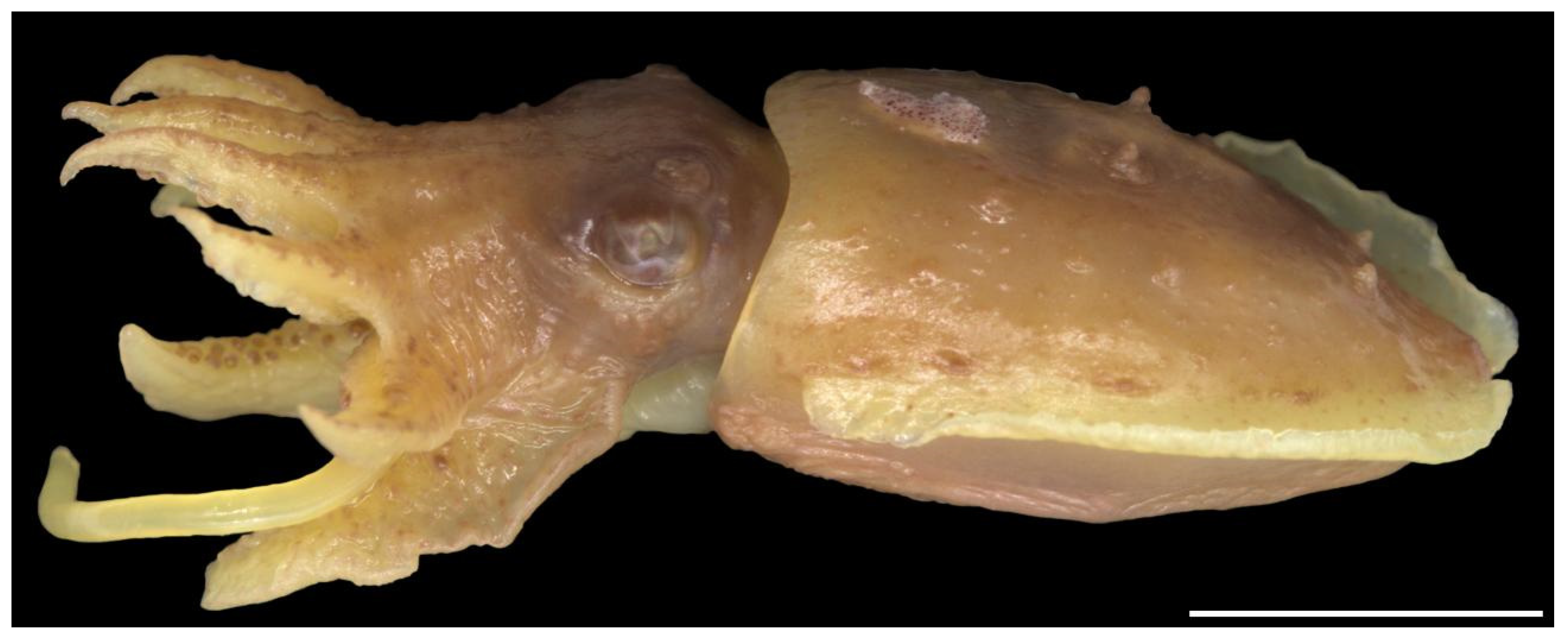
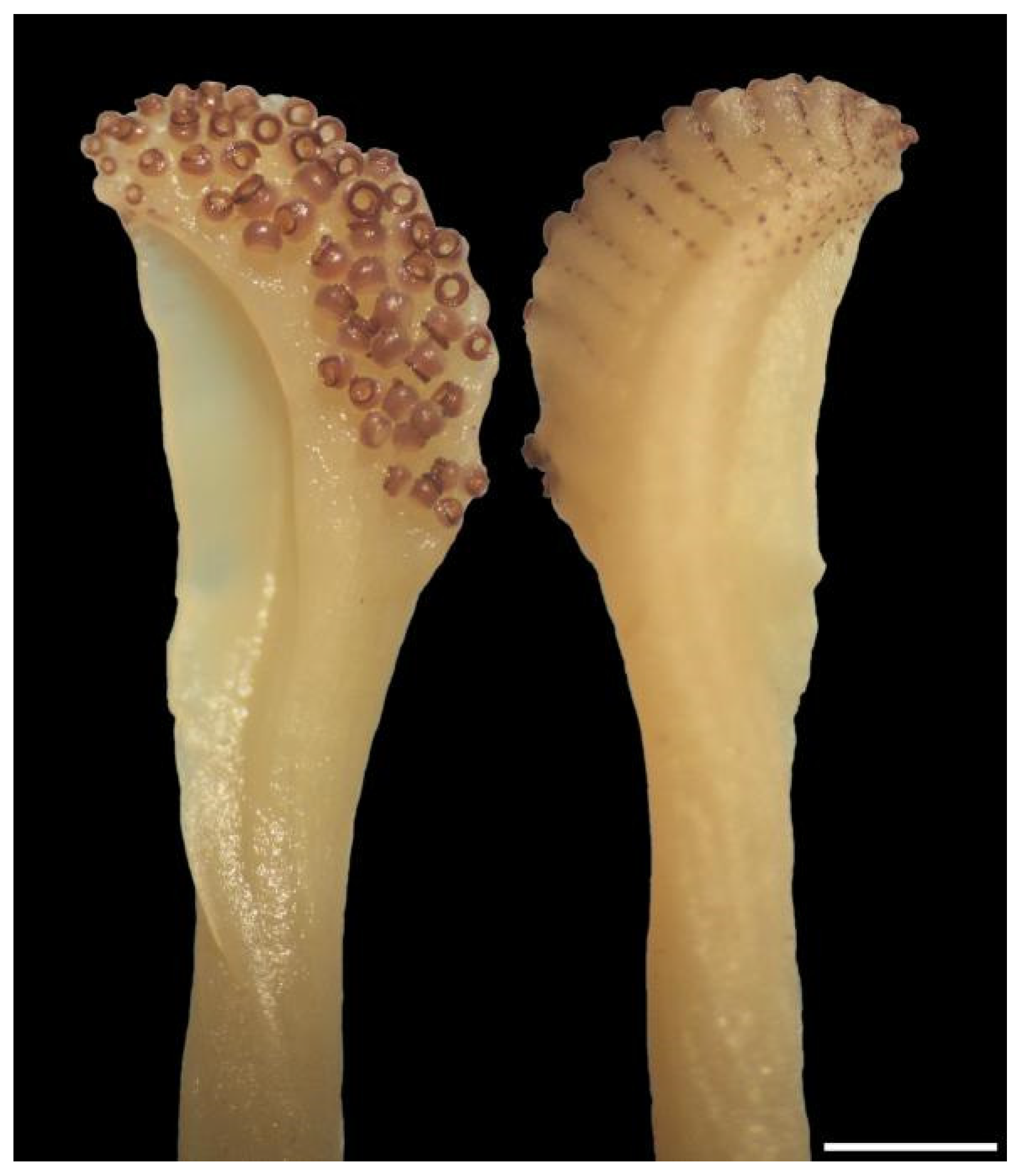




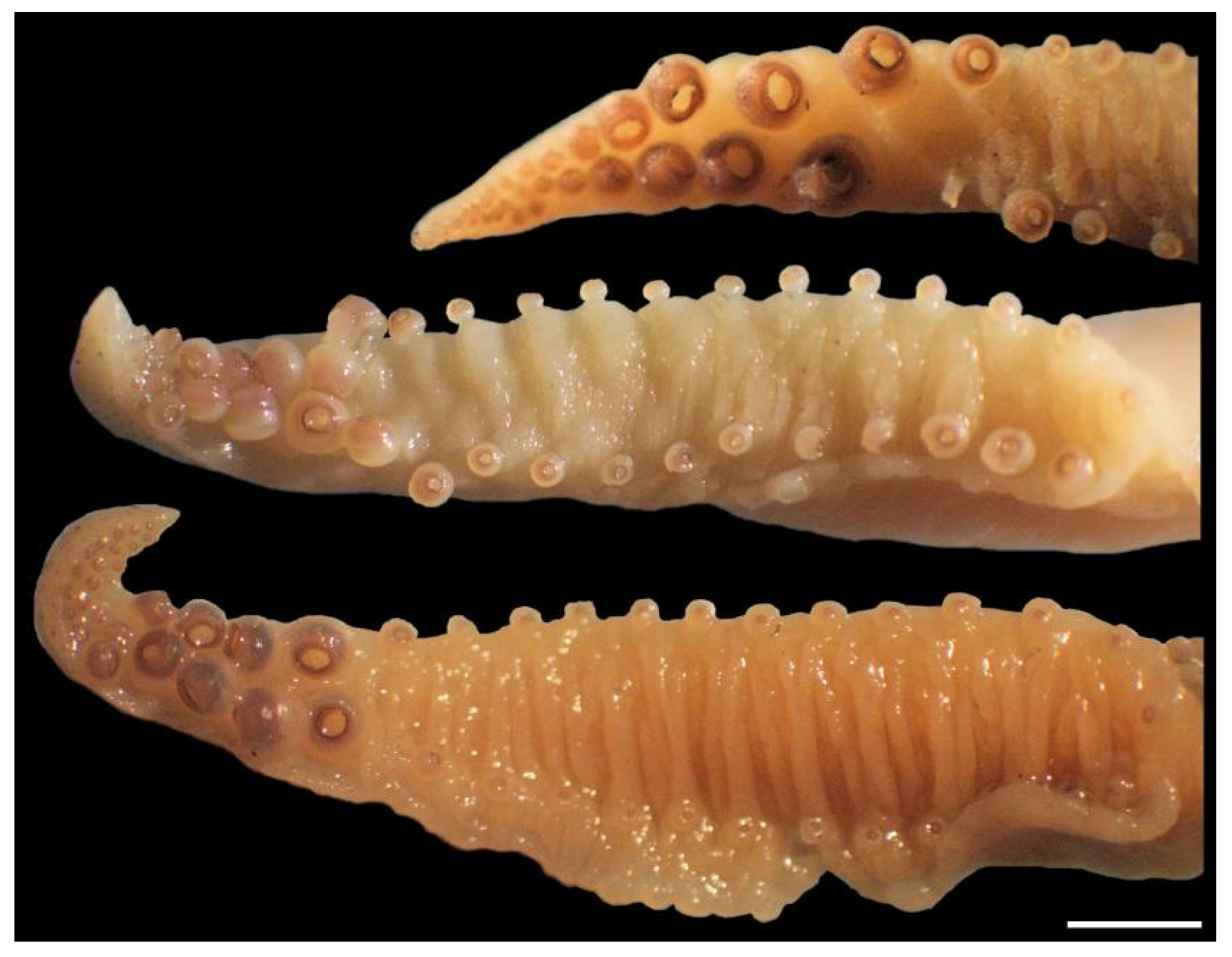
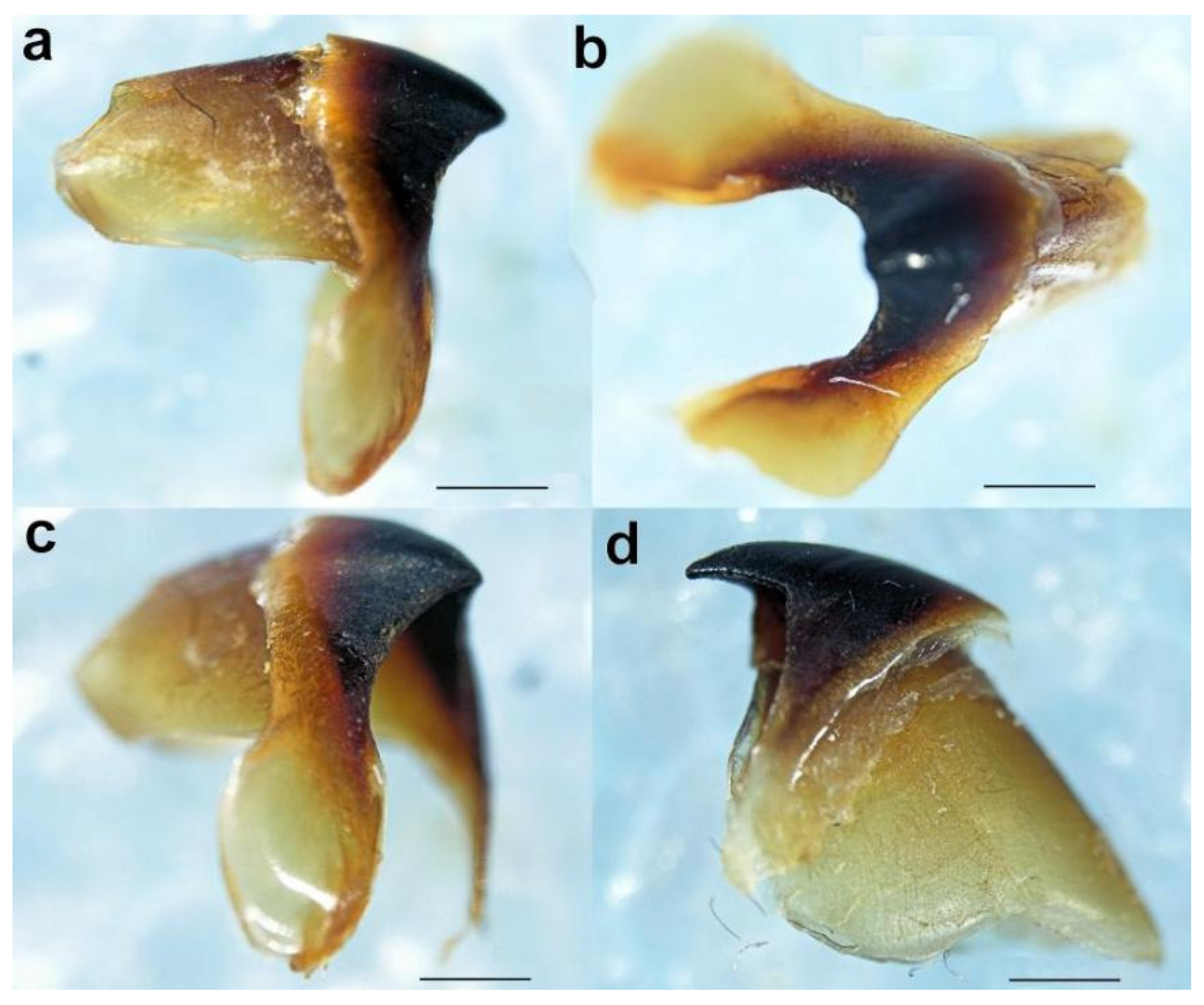





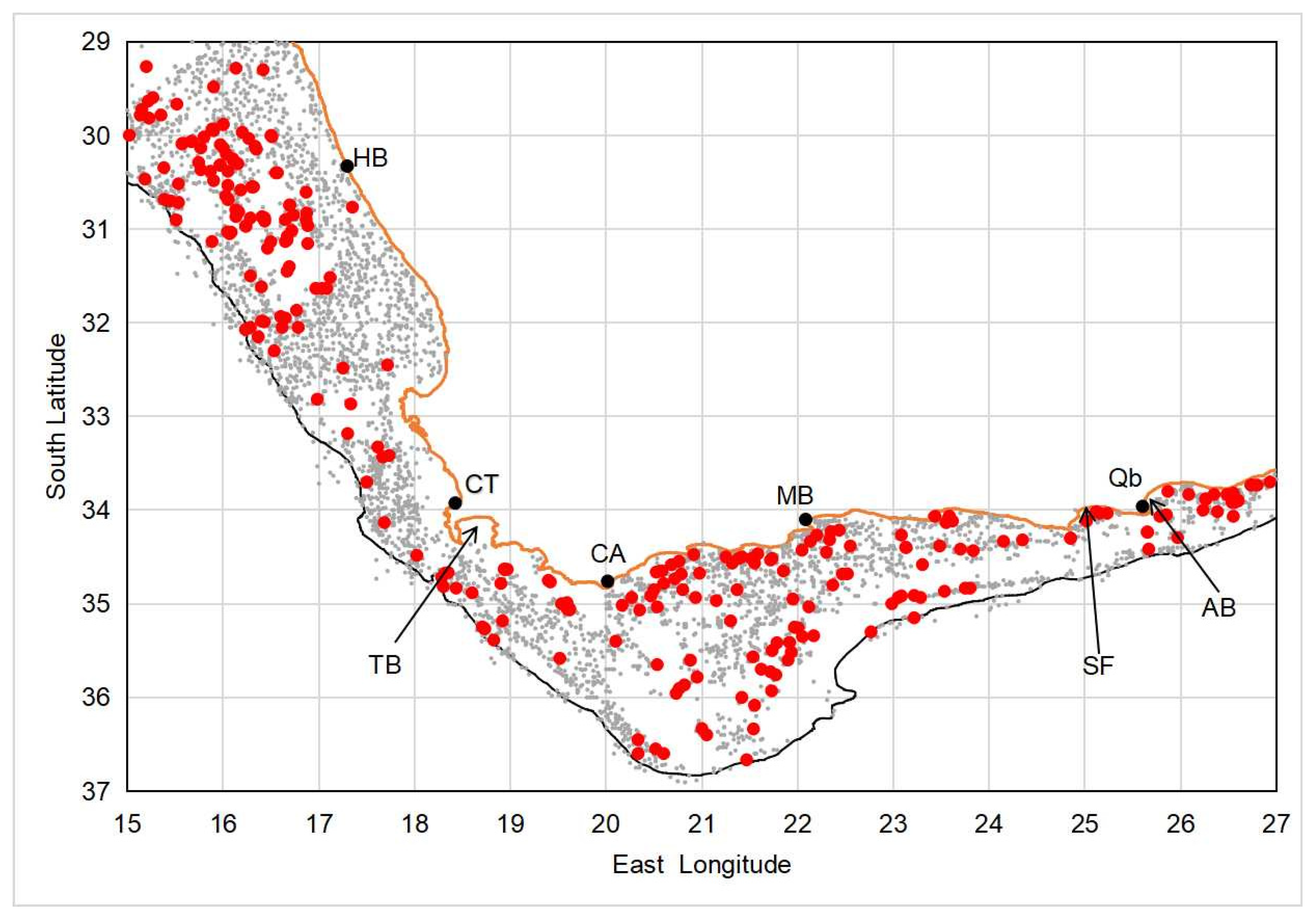
6. Remarks
Supplementary Materials
Author Contributions
Funding
Institutional Review Board Statement
Informed Consent Statement
Data Availability Statement
Acknowledgments
Conflicts of Interest
Appendix A
| Abbreviation | Description or Definition |
|---|---|
| AL1–AL4 | Arm Length: length of the right (rt) or left (lt) of each designated (1 to 4) arm pair. |
| AMH | Anterior Mantle to Head: length of anterior projection of dorsal mantle margin. |
| AS1–AS4 | Arm Sucker Diameter: replaced by AS1c–AS4c; AS1pl–AS4pl and AS1ps–AS4ps (males) or AS1pl–AS4pl (females). |
| AS1c–AS4c | * Arm Sucker Diameter (cluster): diameter of the largest sucker in the distal cluster on the right (rt) or left (lt) arm of each designated (1 to 4) arm pair (males only). |
| AS1pl–AS4pl | * Arm Sucker Diameter (proximal large): diameter of the largest sucker in the proximal sucker field on the right (rt) or left (lt) arm of each designated (1 to 4) arm pair. |
| AS1ps–AS4ps | * Arm Sucker Diameter (proximal small): diameter of the smallest sucker in the proximal sucker field on the right (rt) or left (lt) arm of each designated (1 to 4) arm pair (males only). |
| ASC1–ASC4 | Arm Sucker Count: total number of suckers on the right (rt) or left (lt) arm of each designated (1 to 4) arm pair; sum of the counts of the number of suckers in each defined sucker field. |
| ASC1c–ASC4c | * Arm Sucker Count (cluster): count of suckers in the distal cluster on the right (rt) or left (lt) arm of each designated (1 to 4) arm pair (males only). |
| ASC1nt–ASC4nt | * Arm Sucker Count (no tip): total number of suckers on the right (rt) or left (lt) arm of each designated (1 to 4) arm pair excluding the suckers at the distal tip. |
| ASC1p–ASC4p | * Arm Sucker Count (proximal): count of the suckers in the proximal sucker field on the right (rt) or left (lt) arm of each designated (1 to 4) arm pair (males only). |
| ASC1t–ASC4t | * Arm Sucker Count (tip): count of the suckers at the distal tip of the right (rt) or left (lt) arm of each designated (1 to 4) arm pair. |
| ASC4m | * Arm Sucker Count 4 (mid): count of the suckers in the mid-arm sucker field on the right Arm IV (males only). |
| ASl4 | Arm Sucker left 4: diameter of largest sucker on the hectocotylised left ventral arm (males only). |
| ASl4m | Arm Sucker left 4 minimum: diameter of smallest sucker on the hectocotylised left ventral arm (males only). |
| ClRC | Club Row Count: number of suckers per transverse row across the middle of a tentacular club. |
| ClS | Club Sucker Diameter: diameter of the largest sucker on a tentacular club. |
| CS# | Club Sucker Count: total number of suckers on a tentacular club. |
| FFu | Free Funnel Length: length of the funnel along its dorsal midline. |
| FL | Fin Length: length of the base of the left fin along the curve of mantle. |
| FIa | Fin Insertion Anterior: distance from the anterior mantle margin to the anterior junction of the fin and mantle. |
| FIp | Fin Insertion Posterior: distance between the junction of the left and right fins with the mantle. |
| FuL | Funnel Length: length of the funnel along its ventral midline. |
| FW | Fin Width: width of a single fin at its widest point. |
| HcL | Hectocotylus Length: length of the hectocotylised (left ventral) arm (males only). |
| Hect | Hectocotylus sucker count: total number of suckers on hectocotylised (left ventral) arm; sum of HSCm + HSCc + HSCt (males only). |
| HL | Head Length: length of the head from the nuchal cartilage to the interbranchial membrane |
| HSCm | * Hectocotylus Sucker Count (modified): count of suckers on modified part of hectocotylised (left ventral) arm (males only). |
| HSCt | * Hectocotylus Sucker Count (tip): count of suckers in the tip field of the hectocotylised (left ventral) arm (males only). |
| HSCu | * Hectocotylus Sucker Count (unmodified): count of the unmodified suckers on the hectocotylised (left ventral) arm distal to the modified portion and proximal to the suckers of the tip field (males only). |
| HW | Head Width: the greatest width of the head. |
| L | Length of Cuttlebone: measured along midline. |
| MHL | Modified Hectocotylus Length: of the modified (proximal) portion of the hectocotylus. |
| ML | Mantle Length: length of mantle along the dorsal midline. |
| MLv | Mantle Length (ventral): length of mantle along the ventral midline. |
| P#-lt and P#-rt | * Pore Count: count of the pore openings along the left (lt) or right (rt) antero-marginal ridge. |
| PD-lt and PD-rt | * Pore Distance: measured from the mantle edge to the anterior edge of the first pore opening in the left (lt) or right (rt) antero-marginal ridge. |
| PR-lt and PR-rt | * Pore Row Length: measured in a direct line from the anterior edge of the first (anterior) pore opening to the posterior edge of the last (posterior) pore opening in the left (lt) or right (rt) antero-marginal ridge. |
| Tcl | Tentacular Club Length: measured from the basal sucker to the tip of club. |
| TL | Tentacle Length: measured from point of emergence to from tentacular sac to the tip of the club. |
| TrRC | Transverse Row Count: number of transverse sucker rows along the longitudinal length of the club. |
| TW | Total Weight: measured in grams. |
| Area | Northwest Area | Central Area | Eastern Area | Areas Combined | ||||||||||||||||
|---|---|---|---|---|---|---|---|---|---|---|---|---|---|---|---|---|---|---|---|---|
| Char-acter | n | Min | Max | Mean | Std | n | Min | Max | Mean | Std | n | Min | Max | Mean | Std | n | Min | Max | Mean | Std |
| TW | 21 | 0.91 | 4.45 | 2.66 | 0.79 | 23 | 1.40 | 3.46 | 2.27 | 0.54 | 23 | 0.57 | 3.65 | 2.32 | 0.83 | 67 | 0.57 | 4.45 | 2.41 | 0.74 |
| ML | 22 | 13 | 25 | 19.7 | 2.8 | 23 | 17 | 23 | 19.1 | 2.1 | 23 | 12 | 22 | 18.1 | 2.6 | 68 | 12 | 25 | 19.0 | 2.6 |
| MLv | 22 | 78 | 106 | 89.7 | 6.9 | 22 | 82 | 100 | 90.0 | 4.6 | 23 | 81 | 111 | 89.9 | 6.6 | 67 | 78 | 111 | 89.9 | 6.0 |
| AL1 | 21 | 43 | 62 | 51.5 | 5.0 | 22 | 35 | 53 | 45.7 | 4.4 | 21 | 40 | 60 | 50.2 | 5.9 | 64 | 35 | 62 | 49.1 | 5.6 |
| AL2 | 22 | 44 | 61 | 53.0 | 4.9 | 22 | 40 | 61 | 49.5 | 4.9 | 21 | 44 | 65 | 52.9 | 5.0 | 65 | 40 | 65 | 51.7 | 5.1 |
| AL3 | 22 | 47 | 67 | 57.9 | 5.2 | 22 | 48 | 61 | 55.5 | 3.9 | 21 | 50 | 69 | 57.0 | 4.7 | 65 | 47 | 69 | 56.8 | 4.6 |
| AL4 | 22 | 38 | 80 | 59.7 | 9.7 | 22 | 52 | 79 | 62.7 | 7.0 | 21 | 52 | 89 | 66.4 | 9.7 | 65 | 38 | 89 | 62.9 | 9.2 |
| AMH | 17 | 0.0 | 7.3 | 3.35 | 2.66 | 23 | 0.0 | 7.8 | 3.65 | 1.96 | 21 | 1.5 | 7.6 | 3.99 | 1.59 | 61 | 0.0 | 7.8 | 3.68 | 2.05 |
| AS1c | 20 | 3.0 | 4.6 | 3.86 | 0.41 | 22 | 3.3 | 5.0 | 3.95 | 0.45 | 21 | 2.9 | 4.4 | 3.78 | 0.39 | 63 | 2.9 | 5.0 | 3.86 | 0.42 |
| AS1pl | 21 | 2.7 | 3.9 | 3.45 | 0.34 | 22 | 2.5 | 3.9 | 3.34 | 0.37 | 22 | 2.5 | 4.4 | 3.45 | 0.46 | 65 | 2.5 | 4.4 | 3.41 | 0.39 |
| AS1ps | 19 | 1.7 | 3.9 | 2.87 | 0.62 | 22 | 2.2 | 3.7 | 3.01 | 0.45 | 21 | 2.4 | 3.9 | 3.10 | 0.38 | 62 | 1.7 | 3.9 | 3.00 | 0.49 |
| AS2c | 21 | 3.1 | 5.4 | 4.55 | 0.52 | 22 | 3.5 | 5.5 | 4.42 | 0.52 | 22 | 2.9 | 5.4 | 4.50 | 0.57 | 65 | 2.9 | 5.5 | 4.49 | 0.53 |
| AS2pl | 21 | 3.1 | 4.4 | 3.66 | 0.37 | 22 | 3.0 | 4.4 | 3.74 | 0.40 | 22 | 3.3 | 4.7 | 3.93 | 0.37 | 65 | 3.0 | 4.7 | 3.78 | 0.39 |
| AS2ps | 21 | 2.2 | 3.9 | 3.24 | 0.47 | 22 | 2.4 | 4.1 | 3.35 | 0.46 | 22 | 2.5 | 4.1 | 3.45 | 0.40 | 65 | 2.2 | 4.1 | 3.35 | 0.45 |
| AS3c | 22 | 3.1 | 4.7 | 3.96 | 0.41 | 22 | 3.5 | 5.0 | 4.02 | 0.41 | 22 | 2.9 | 4.4 | 3.91 | 0.36 | 66 | 2.9 | 5.0 | 3.96 | 0.39 |
| AS3pl | 22 | 3.1 | 4.7 | 3.99 | 0.42 | 22 | 3.5 | 5.6 | 4.17 | 0.53 | 22 | 3.5 | 5.6 | 4.32 | 0.51 | 66 | 3.1 | 5.6 | 4.16 | 0.50 |
| AS3ps | 22 | 1.7 | 3.9 | 3.07 | 0.48 | 22 | 2.2 | 4.1 | 3.26 | 0.50 | 22 | 2.4 | 4.4 | 3.35 | 0.44 | 66 | 1.7 | 4.4 | 3.22 | 0.48 |
| AS4c | 19 | 1.9 | 3.5 | 2.94 | 0.37 | 22 | 2.4 | 3.5 | 2.97 | 0.36 | 20 | 1.8 | 3.8 | 2.94 | 0.50 | 61 | 1.8 | 3.8 | 2.95 | 0.41 |
| AS4pl | 20 | 3.1 | 5.9 | 4.75 | 0.73 | 22 | 4.0 | 6.3 | 4.92 | 0.65 | 22 | 4.0 | 6.2 | 5.07 | 0.54 | 64 | 3.1 | 6.3 | 4.92 | 0.64 |
| AS4ps | 19 | 1.4 | 2.8 | 2.23 | 0.35 | 22 | 1.1 | 3.0 | 2.27 | 0.57 | 20 | 1.5 | 2.8 | 2.30 | 0.31 | 61 | 1.1 | 3.0 | 2.26 | 0.42 |
| ASl4 | 21 | 1.9 | 3.6 | 2.84 | 0.37 | 22 | 2.0 | 3.5 | 2.93 | 0.39 | 22 | 2.0 | 3.7 | 2.94 | 0.39 | 65 | 1.9 | 3.7 | 2.90 | 0.38 |
| ASl4m | 21 | 0.8 | 1.5 | 1.10 | 0.18 | 22 | 0.9 | 1.2 | 1.06 | 0.11 | 22 | 0.5 | 1.5 | 1.05 | 0.25 | 65 | 0.5 | 1.5 | 1.07 | 0.19 |
| ClS | 14 | 0.9 | 1.4 | 1.14 | 0.18 | 22 | 0.9 | 1.7 | 1.20 | 0.22 | 19 | 0.9 | 1.6 | 1.13 | 0.18 | 55 | 0.9 | 1.7 | 1.16 | 0.19 |
| FFu | 22 | 14 | 29 | 22.8 | 3.9 | 23 | 11 | 29 | 17.1 | 4.2 | 22 | 14 | 33 | 21.5 | 4.1 | 67 | 11 | 33 | 20.4 | 4.7 |
| FIa | 22 | 7.0 | 18.0 | 12.64 | 3.61 | 23 | 6.0 | 16.0 | 9.70 | 2.67 | 21 | 5.0 | 17.0 | 11.57 | 2.56 | 66 | 5.0 | 18.0 | 11.27 | 3.19 |
| FIp | 21 | 0.0 | 6.7 | 2.69 | 1.78 | 23 | 0.5 | 8.3 | 3.70 | 1.91 | 20 | 1.6 | 7.5 | 3.77 | 1.28 | 64 | 0.0 | 8.3 | 3.39 | 1.74 |
| FL | 22 | 78 | 115 | 101.7 | 10.0 | 23 | 81 | 124 | 108.6 | 9.5 | 21 | 95 | 126 | 107.4 | 9.2 | 66 | 78 | 126 | 105.9 | 9.9 |
| FuL | 22 | 36 | 63 | 50.8 | 6.7 | 23 | 39 | 59 | 46.2 | 5.1 | 22 | 42 | 56 | 46.4 | 3.5 | 67 | 36 | 63 | 47.8 | 5.6 |
| FW | 22 | 3.8 | 18.2 | 7.82 | 3.18 | 23 | 4.8 | 15.2 | 9.14 | 2.96 | 21 | 4.5 | 11.8 | 7.68 | 1.75 | 66 | 3.8 | 18.2 | 8.23 | 2.76 |
| HcL | 22 | 45 | 75 | 58.7 | 7.9 | 22 | 50 | 61 | 56.8 | 2.6 | 21 | 53 | 74 | 61.3 | 6.2 | 65 | 45 | 75 | 58.9 | 6.2 |
| HL | 22 | 56 | 77 | 65.4 | 6.2 | 23 | 55 | 71 | 63.0 | 4.8 | 23 | 55 | 73 | 64.5 | 5.4 | 68 | 55 | 77 | 64.3 | 5.5 |
| HW | 22 | 48 | 69 | 57.1 | 5.3 | 23 | 45 | 61 | 53.6 | 4.3 | 23 | 47 | 67 | 54.8 | 4.6 | 68 | 45 | 69 | 55.1 | 4.9 |
| MHL | 22 | 47 | 71 | 58.5 | 6.9 | 22 | 40 | 64 | 57.3 | 6.1 | 21 | 43 | 70 | 58.0 | 6.7 | 65 | 40 | 71 | 58.4 | 6.5 |
| PD-lt | 22 | 1.8 | 13.9 | 8.07 | 3.68 | 21 | 2.9 | 11.8 | 7.11 | 2.34 | 20 | 1.0 | 12.1 | 7.67 | 2.70 | 63 | 1.0 | 13.9 | 7.62 | 2.96 |
| PD-rt | 22 | 2.7 | 14.7 | 9.62 | 3.15 | 23 | 3.6 | 12.4 | 7.96 | 2.51 | 21 | 1.5 | 14.7 | 8.12 | 3.27 | 66 | 1.5 | 14.7 | 8.57 | 3.03 |
| PR-lt | 22 | 31 | 58 | 43.2 | 7.6 | 21 | 33 | 54 | 41.1 | 5.2 | 19 | 36 | 51 | 42.9 | 4.1 | 62 | 31 | 58 | 42.4 | 5.9 |
| PR-rt | 22 | 33 | 56 | 43.68 | 6.49 | 23 | 28 | 50 | 42.78 | 5.09 | 21 | 29 | 54 | 42.05 | 5.56 | 66 | 28 | 56 | 42.85 | 5.69 |
| Tcl | 14 | 13 | 21 | 16.0 | 2.5 | 22 | 11 | 24 | 15.7 | 2.9 | 19 | 10 | 23 | 16.1 | 2.7 | 55 | 10 | 24 | 15.9 | 2.7 |
| TL | 14 | 150 | 217 | 186.4 | 21.7 | 21 | 65 | 229 | 133.6 | 42.3 | 19 | 67 | 206 | 166.2 | 32.8 | 54 | 65 | 229 | 158.7 | 40.4 |
| Area | Northwest Area | Central Area | Eastern Area | Areas Combined | ||||||||||||||||
|---|---|---|---|---|---|---|---|---|---|---|---|---|---|---|---|---|---|---|---|---|
| Char-acter | n | Min | Max | Mean | Std | n | Min | Max | Mean | Std | n | Min | Max | Mean | Std | n | Min | Max | Mean | Std |
| TW | 18 | 0.78 | 5.05 | 3.20 | 1.15 | 15 | 0.90 | 4.07 | 2.30 | 0.72 | 26 | 1.26 | 4.48 | 2.90 | 0.88 | 59 | 0.78 | 5.05 | 2.84 | 0.98 |
| ML | 18 | 12 | 25 | 19.9 | 3.3 | 15 | 12 | 23 | 18.0 | 2.8 | 26 | 14 | 24 | 19.2 | 2.3 | 59 | 12 | 25 | 19.1 | 2.8 |
| MLv | 18 | 83 | 100 | 91.6 | 4.8 | 13 | 75 | 106 | 90.6 | 8.6 | 26 | 75 | 100 | 90.3 | 6.0 | 57 | 75 | 106 | 90.8 | 6.3 |
| AL1 | 18 | 43 | 61 | 49.4 | 4.3 | 14 | 36 | 61 | 45.6 | 7.5 | 26 | 35 | 58 | 44.1 | 5.0 | 58 | 35 | 61 | 46.1 | 5.9 |
| AL2 | 18 | 40 | 58 | 49.2 | 4.3 | 15 | 36 | 53 | 44.1 | 4.7 | 26 | 40 | 53 | 44.0 | 3.4 | 59 | 36 | 58 | 45.6 | 4.6 |
| AL3 | 18 | 43 | 61 | 50.0 | 5.0 | 15 | 41 | 53 | 45.9 | 4.2 | 26 | 38 | 50 | 44.4 | 3.6 | 59 | 38 | 61 | 46.5 | 4.8 |
| AL4 | 18 | 33 | 69 | 54.8 | 8.0 | 15 | 42 | 67 | 53.4 | 7.9 | 26 | 40 | 68 | 52.7 | 6.8 | 59 | 33 | 69 | 53.5 | 7.4 |
| AMH | 13 | 0.0 | 6.7 | 4.19 | 1.90 | 11 | 0.0 | 8.9 | 4.34 | 2.17 | 24 | 1.6 | 7.5 | 3.96 | 1.55 | 48 | 0.0 | 8.9 | 4.11 | 1.76 |
| AS1pl | 18 | 2.4 | 4.2 | 2.90 | 0.44 | 15 | 2.6 | 4.7 | 3.27 | 0.58 | 26 | 2.2 | 3.6 | 2.90 | 0.35 | 59 | 2.2 | 4.7 | 2.99 | 0.47 |
| AS2pl | 18 | 2.4 | 4.2 | 3.01 | 0.45 | 15 | 2.6 | 3.5 | 3.05 | 0.35 | 26 | 2.5 | 3.9 | 3.05 | 0.36 | 59 | 2.4 | 4.2 | 3.04 | 0.38 |
| AS3pl | 18 | 2.6 | 5.0 | 3.07 | 0.52 | 15 | 2.6 | 4.0 | 3.24 | 0.46 | 26 | 2.5 | 3.9 | 2.90 | 0.41 | 59 | 2.5 | 5.0 | 3.04 | 0.47 |
| AS4pl | 18 | 2.6 | 4.2 | 3.08 | 0.37 | 15 | 2.6 | 3.5 | 3.05 | 0.35 | 26 | 2.4 | 3.7 | 2.91 | 0.30 | 59 | 2.4 | 4.2 | 3.00 | 0.34 |
| ClS | 16 | 0.9 | 1.7 | 1.23 | 0.25 | 12 | 1.1 | 2.0 | 1.34 | 0.29 | 20 | 0.8 | 1.7 | 1.22 | 0.24 | 48 | 0.8 | 2.0 | 1.25 | 0.26 |
| FFu | 18 | 13 | 31 | 21.7 | 4.6 | 15 | 13 | 30 | 21.1 | 5.4 | 25 | 13 | 29 | 20.6 | 3.4 | 58 | 13 | 31 | 21.1 | 4.3 |
| FIa | 18 | 6.0 | 20.0 | 13.4 | 4.2 | 14 | 7.0 | 18.0 | 12.64 | 3.48 | 25 | 7.0 | 18.0 | 12.00 | 3.30 | 57 | 6.0 | 20.0 | 12.61 | 3.63 |
| FIp | 18 | 0.0 | 6.7 | 2.22 | 1.69 | 14 | 0.0 | 6.1 | 2.50 | 1.79 | 25 | 0.5 | 8.4 | 4.13 | 1.73 | 57 | 0.0 | 8.4 | 3.13 | 1.93 |
| FL | 18 | 75 | 128 | 104.3 | 11.5 | 14 | 95 | 121 | 105.7 | 6.8 | 25 | 100 | 136 | 112.3 | 8.8 | 57 | 75 | 136 | 108.2 | 9.9 |
| FuL | 17 | 44 | 60 | 51.1 | 4.6 | 15 | 39 | 53 | 47.8 | 5.0 | 25 | 30 | 59 | 46.5 | 7.8 | 57 | 30 | 60 | 48.2 | 6.5 |
| FW | 18 | 4.2 | 15.6 | 8.58 | 2.53 | 15 | 5.3 | 11.8 | 8.18 | 1.93 | 26 | 2.5 | 15.8 | 7.56 | 2.65 | 59 | 2.5 | 15.8 | 8.03 | 2.45 |
| HL | 18 | 56 | 78 | 67.2 | 6.0 | 15 | 55 | 78 | 63.9 | 7.2 | 26 | 55 | 71 | 62.2 | 4.2 | 59 | 55 | 78 | 64.2 | 6.0 |
| HW | 18 | 50 | 75 | 57.9 | 7.4 | 15 | 43 | 67 | 55.7 | 5.9 | 26 | 45 | 64 | 53.1 | 3.8 | 59 | 43 | 75 | 55.2 | 5.9 |
| PD-lt | 14 | 3.5 | 14.8 | 9.55 | 3.67 | 11 | 1.1 | 11.7 | 8.85 | 3.22 | 23 | 1.3 | 13.9 | 7.42 | 2.54 | 48 | 1.1 | 14.8 | 8.37 | 3.14 |
| PD-rt | 14 | 1.0 | 21.9 | 9.96 | 5.06 | 12 | 2.1 | 12.2 | 8.61 | 2.85 | 25 | 3.5 | 13.0 | 8.51 | 2.70 | 51 | 1.0 | 21.9 | 8.93 | 3.51 |
| PR-lt | 15 | 37 | 57 | 45.9 | 5.4 | 11 | 33 | 51 | 42.5 | 5.4 | 23 | 38 | 65 | 46.0 | 6.4 | 49 | 33 | 65 | 45.2 | 6.0 |
| PR-rt | 14 | 35 | 50 | 44.0 | 5.5 | 12 | 33 | 53 | 42.00 | 5.75 | 25 | 39 | 71 | 46.32 | 7.14 | 51 | 33 | 71 | 44.67 | 6.54 |
| Tcl | 16 | 13 | 25 | 17.3 | 3.1 | 12 | 11 | 22 | 17.1 | 2.7 | 21 | 13 | 22 | 18.0 | 2.5 | 49 | 11 | 25 | 17.5 | 2.7 |
| TL | 16 | 100 | 267 | 190.8 | 45.3 | 12 | 100 | 224 | 166.3 | 38.7 | 21 | 125 | 235 | 174.3 | 31.0 | 49 | 100 | 267 | 177.8 | 38.4 |
| Area | Northwest Area | Central Area | Eastern Area | Areas Combined | ||||||||||||||||
|---|---|---|---|---|---|---|---|---|---|---|---|---|---|---|---|---|---|---|---|---|
| Char-acter | n | Min | Max | Mean | Std | n | Min | Max | Mean | Std | n | Min | Max | Mean | Std | n | Min | Max | Mean | Std |
| ASC1 | 20 | 29 | 44 | 36.2 | 3.9 | 22 | 28 | 42 | 35.2 | 3.4 | 22 | 30 | 41 | 35.6 | 3.2 | 64 | 28 | 44 | 35.6 | 3.5 |
| ASC1c | 21 | 5 | 7 | 6.1 | 0.4 | 22 | 5 | 8 | 6.3 | 0.7 | 22 | 4 | 8 | 6.4 | 1.1 | 65 | 4 | 8 | 6.3 | 0.8 |
| ASC1nt | 21 | 19 | 24 | 21.5 | 1.3 | 22 | 18 | 23 | 20.2 | 1.2 | 22 | 18 | 24 | 21 | 1.8 | 65 | 18 | 24 | 20.9 | 1.5 |
| ASC1p | 21 | 13 | 18 | 15.4 | 1.2 | 22 | 12 | 17 | 13.9 | 1.1 | 22 | 12 | 18 | 14.7 | 1.3 | 65 | 12 | 18 | 14.6 | 1.4 |
| ASC1t | 20 | 10 | 22 | 14.6 | 3.4 | 22 | 9 | 20 | 15.0 | 3.2 | 22 | 11 | 18 | 14.6 | 2.0 | 64 | 9 | 22 | 14.7 | 2.9 |
| ASC2 | 21 | 27 | 44 | 36.9 | 4.4 | 22 | 25 | 42 | 33.3 | 5.0 | 22 | 31 | 42 | 37.0 | 2.9 | 65 | 25 | 44 | 35.7 | 4.5 |
| ASC2c | 22 | 4 | 9 | 6.1 | 1.1 | 22 | 4 | 8 | 6.3 | 0.9 | 22 | 6 | 9 | 6.6 | 1.0 | 66 | 4 | 9 | 6.3 | 1.0 |
| ASC2nt | 22 | 20 | 26 | 22.7 | 1.8 | 22 | 19 | 24 | 21.1 | 1.5 | 22 | 20 | 26 | 22.1 | 1.6 | 66 | 19 | 26 | 22 | 1.7 |
| ASC2p | 22 | 14 | 19 | 16.5 | 1.3 | 22 | 13 | 17 | 14.8 | 1.1 | 22 | 13 | 18 | 15.5 | 1.2 | 66 | 13 | 19 | 15.6 | 1.4 |
| ASC2t | 21 | 5 | 21 | 14.1 | 3.9 | 22 | 4 | 19 | 12.2 | 4.5 | 22 | 10 | 20 | 14.9 | 2.5 | 65 | 4 | 21 | 13.7 | 3.8 |
| ASC3 | 22 | 29 | 49 | 42.2 | 4.3 | 22 | 32 | 48 | 40.6 | 4.6 | 22 | 37 | 48 | 41.7 | 2.9 | 66 | 29 | 49 | 41.5 | 4.0 |
| ASC3c | 21 | 6 | 8 | 6.3 | 0.6 | 22 | 4 | 8 | 6.3 | 0.9 | 20 | 4 | 8 | 6.4 | 0.9 | 63 | 4 | 8 | 6.3 | 0.8 |
| ASC3nt | 22 | 24 | 31 | 28.1 | 1.8 | 22 | 24 | 31 | 26.5 | 1.6 | 22 | 23 | 32 | 27.1 | 1.9 | 66 | 23 | 32 | 27.2 | 1.9 |
| ASC3p | 22 | 18 | 27 | 22.1 | 2.0 | 22 | 18 | 24 | 20.2 | 1.3 | 22 | 17 | 28 | 21.3 | 2.6 | 66 | 17 | 28 | 21.2 | 2.1 |
| ASC3t | 22 | 4 | 21 | 14.1 | 3.9 | 22 | 6 | 20 | 14.0 | 3.7 | 22 | 11 | 21 | 14.6 | 2.2 | 66 | 4 | 21 | 14.3 | 3.3 |
| ASC4 | 20 | 40 | 54 | 45.7 | 4.2 | 22 | 35 | 55 | 44.7 | 6.0 | 21 | 37 | 52 | 45.4 | 3.9 | 63 | 35 | 55 | 45.2 | 4.8 |
| ASC4c | 19 | 6 | 10 | 8.0 | 1.4 | 22 | 6 | 12 | 9.1 | 1.5 | 21 | 6 | 12 | 9.2 | 1.6 | 62 | 6 | 12 | 8.8 | 1.6 |
| ASC4m | 19 | 7 | 14 | 10.6 | 1.8 | 22 | 6 | 10 | 8.5 | 1.4 | 22 | 4 | 11 | 7.9 | 1.8 | 63 | 4 | 14 | 8.9 | 2.0 |
| ASC4nt | 19 | 27 | 34 | 30.8 | 1.9 | 22 | 25 | 34 | 30.1 | 2.6 | 21 | 26 | 36 | 30.4 | 2.5 | 62 | 25 | 36 | 30.4 | 2.4 |
| ASC4p | 19 | 10 | 14 | 12.2 | 1.3 | 22 | 10 | 15 | 12.5 | 1.5 | 22 | 11 | 16 | 13.1 | 1.3 | 63 | 10 | 16 | 12.6 | 1.4 |
| ASC4t | 19 | 10 | 22 | 15.1 | 3.7 | 22 | 3 | 22 | 14.6 | 4.9 | 22 | 11 | 22 | 15.1 | 2.7 | 63 | 3 | 22 | 14.9 | 3.8 |
| ClRC | 14 | 4 | 4 | 4.0 | 0.0 | 22 | 4 | 4 | 4.0 | 0.0 | 19 | 4 | 4 | 4.0 | 0.0 | 55 | 4 | 4 | 4.0 | 0.0 |
| CS# | 14 | 42 | 62 | 51.6 | 5.1 | 22 | 39 | 60 | 48.6 | 5.5 | 19 | 43 | 57 | 49.3 | 3.6 | 55 | 39 | 62 | 49.6 | 4.9 |
| Hect | 21 | 40 | 54 | 46.1 | 3.6 | 22 | 30 | 53 | 43.1 | 5.8 | 22 | 40 | 53 | 47.4 | 3.5 | 65 | 30 | 54 | 45.6 | 4.7 |
| HSCm | 21 | 18 | 23 | 21.2 | 1.6 | 22 | 17 | 23 | 20.5 | 1.5 | 22 | 18 | 26 | 21.4 | 1.9 | 65 | 17 | 26 | 21.0 | 1.7 |
| HSCt | 21 | 10 | 22 | 15.2 | 3.1 | 22 | 2 | 21 | 13.7 | 5.5 | 22 | 13 | 21 | 16.6 | 2.2 | 65 | 2 | 22 | 15.2 | 4.0 |
| HSCu | 21 | 8 | 13 | 9.8 | 1.6 | 22 | 6 | 11 | 8.9 | 1.2 | 22 | 7 | 13 | 9.4 | 1.2 | 65 | 6 | 13 | 9.4 | 1.4 |
| P#-lt | 21 | 10 | 13 | 11.6 | 1.2 | 22 | 9 | 13 | 10.7 | 1.1 | 20 | 8 | 13 | 11.1 | 1.5 | 63 | 8 | 13 | 11.1 | 1.3 |
| P#-rt | 22 | 9 | 15 | 11.5 | 1.7 | 23 | 9 | 13 | 10.6 | 1.1 | 21 | 8 | 13 | 10.6 | 1.2 | 66 | 8 | 15 | 10.9 | 1.4 |
| TrRC | 13 | 12 | 15 | 14.1 | 1.0 | 22 | 11 | 15 | 13.5 | 1.2 | 19 | 12 | 15 | 13.7 | 1.0 | 55 | 11 | 15 | 13.7 | 1.1 |
| Area | Northwest Area | Central Area | Eastern Area | Areas Combined | ||||||||||||||||
|---|---|---|---|---|---|---|---|---|---|---|---|---|---|---|---|---|---|---|---|---|
| Char-acter | n | Min | Max | Mean | Std | n | Min | Max | Mean | Std | n | Min | Max | Mean | Std | n | Min | Max | Mean | Std |
| ASC1 | 18 | 32 | 52 | 43.2 | 4.9 | 15 | 34 | 49 | 41.4 | 4.1 | 26 | 35 | 52 | 41.6 | 4.4 | 59 | 32 | 52 | 42.0 | 4.5 |
| ASC1nt | 18 | 21 | 34 | 29.4 | 3.4 | 15 | 24 | 36 | 28.9 | 3.5 | 26 | 21 | 37 | 29.2 | 3.8 | 59 | 21 | 37 | 29.2 | 3.5 |
| ASC1t | 18 | 10 | 20 | 13.8 | 2.4 | 15 | 10 | 16 | 12.5 | 1.8 | 26 | 6 | 20 | 12.5 | 2.8 | 59 | 6 | 20 | 12.9 | 2.5 |
| ASC2 | 18 | 33 | 56 | 44.8 | 5.0 | 15 | 33 | 47 | 42.3 | 3.8 | 26 | 35 | 54 | 44.2 | 4.3 | 59 | 33 | 56 | 43.9 | 4.4 |
| ASC2nt | 18 | 23 | 37 | 30.4 | 3.6 | 15 | 24 | 34 | 28.9 | 2.9 | 26 | 24 | 38 | 31.0 | 3.2 | 59 | 23 | 38 | 30.3 | 3.3 |
| ASC2t | 18 | 10 | 19 | 14.4 | 2.8 | 15 | 9 | 18 | 13.5 | 2.6 | 26 | 9 | 17 | 13.2 | 2.2 | 59 | 9 | 19 | 13.7 | 2.5 |
| ASC3 | 18 | 34 | 60 | 50.1 | 6.1 | 15 | 41 | 53 | 47.2 | 3.9 | 26 | 45 | 59 | 50.5 | 4.1 | 59 | 34 | 60 | 49.5 | 4.9 |
| ASC3nt | 18 | 27 | 44 | 34.4 | 4.4 | 15 | 24 | 41 | 32.1 | 4.1 | 26 | 30 | 42 | 35.9 | 3.0 | 59 | 24 | 44 | 34.5 | 4.0 |
| ASC3t | 18 | 7 | 21 | 15.6 | 4.0 | 15 | 12 | 19 | 15.1 | 2.1 | 26 | 11 | 21 | 14.6 | 2.4 | 59 | 7 | 21 | 15.0 | 2.9 |
| ASC4 | 18 | 42 | 59 | 50.1 | 4.6 | 15 | 44 | 56 | 49.3 | 3.7 | 26 | 42 | 59 | 50.9 | 5.1 | 59 | 42 | 59 | 50.3 | 4.6 |
| ASC4nt | 18 | 30 | 39 | 34.4 | 2.6 | 15 | 29 | 41 | 32.7 | 2.9 | 26 | 28 | 43 | 34.7 | 3.2 | 59 | 28 | 43 | 34.1 | 3.0 |
| ASC4t | 18 | 7 | 21 | 15.7 | 3.8 | 15 | 13 | 22 | 16.7 | 2.6 | 26 | 9 | 23 | 16.2 | 3.6 | 59 | 7 | 23 | 16.2 | 3.4 |
| ClRC | 16 | 4 | 4 | 4.0 | 0.0 | 12 | 4 | 4 | 4.0 | 0.0 | 21 | 4 | 4 | 4.0 | 0.0 | 49 | 4 | 4 | 4.0 | 0.0 |
| CS# | 16 | 43 | 58 | 52.4 | 4.4 | 12 | 42 | 54 | 48.0 | 3.3 | 21 | 47 | 63 | 52.3 | 3.8 | 49 | 42 | 63 | 51.3 | 4.3 |
| P#-lt | 16 | 9 | 14 | 11.8 | 1.4 | 11 | 8 | 13 | 11.4 | 1.5 | 23 | 8 | 13 | 11.0 | 1.5 | 50 | 8 | 14 | 11.3 | 1.5 |
| P#-rt | 15 | 10 | 15 | 11.9 | 1.2 | 13 | 9 | 15 | 11.1 | 1.5 | 25 | 9 | 14 | 11.6 | 1.3 | 53 | 9 | 15 | 11.5 | 1.3 |
| TrRC | 16 | 12 | 16 | 13.8 | 1.1 | 12 | 12 | 14 | 13.2 | 0.6 | 21 | 13 | 15 | 13.9 | 0.7 | 49 | 12 | 16 | 14.0 | 0.9 |
| Y | a | b | r2 | Sig. | Y | a | b | r | Sig. | Y | a | b | r | Sig. | ||
|---|---|---|---|---|---|---|---|---|---|---|---|---|---|---|---|---|
| Females | Males | Males (continued) | ||||||||||||||
| AL 1 | 0.99 | 0.41 | 0.51 | *** | AL 1 | 2.75 | 0.34 | 0.39 | *** | AS4ps | 0.05 | 0.02 | 0.26 | *** | ||
| AL 2 | 0.04 | 0.45 | 0.67 | *** | AL 2 | 1.65 | 0.43 | 0.56 | *** | ASl4 | 0.05 | 0.03 | 0.42 | *** | ||
| AL 3 | 1.52 | 0.38 | 0.59 | *** | AL 3 | 0.84 | 0.52 | 0.68 | *** | ASl4m | 0.17 | 0.00 | 0.02 | NS | ||
| AL 4 | 2.9 | 0.38 | 0.40 | *** | AL 4 | 2.59 | 0.49 | 0.32 | *** | FFu | 2.02 | 0.09 | 0.06 | * | ||
| AS1pl | 0.33 | 0.01 | 0.22 | *** | AMH | −0.57 | 0.07 | 0.16 | ** | FIa | 0.71 | 0.07 | 0.08 | * | ||
| AS2pl | 0.25 | 0.02 | 0.39 | *** | AS1c | 0.29 | 0.02 | 0.35 | *** | FIp | 0 | 0.03 | 0.05 | NS | ||
| AS3pl | 0.27 | 0.02 | 0.30 | *** | AS1pl | 0.19 | 0.02 | 0.47 | *** | FL | 1.63 | 0.97 | 0.62 | *** | ||
| AS4pl | 0.19 | 0.02 | 0.52 | *** | AS1ps | 0.19 | 0.02 | 0.21 | *** | FuL | 1.89 | 0.38 | 0.38 | *** | ||
| FFu | 0.23 | 0.20 | 0.31 | *** | AS2c | 0.17 | 0.04 | 0.47 | *** | FW | −1.15 | 0.14 | 0.29 | *** | ||
| FIa | 0.83 | 0.08 | 0.10 | * | AS2pl | 0.23 | 0.03 | 0.47 | *** | HcL | 1.21 | 0.52 | 0.53 | *** | ||
| FIp | 0.23 | 0.03 | 0.01 | NS | AS2ps | 0.17 | 0.02 | 0.35 | *** | HL | 3.73 | 0.44 | 0.58 | *** | ||
| FL | 1.06 | 1.03 | 0.74 | *** | AS3c | 0.08 | 0.04 | 0.59 | *** | HW | 3.14 | 0.38 | 0.60 | *** | ||
| FuL | 3.75 | 0.28 | 0.33 | *** | AS3pl | 0.22 | 0.03 | 0.42 | *** | MHL | 1.6 | 0.26 | 0.34 | *** | ||
| FW | −0.06 | 0.08 | 0.20 | *** | AS3ps | 0.09 | 0.03 | 0.38 | *** | MLv | 2.42 | 0.77 | 0.75 | *** | ||
| HL | 2.31 | 0.51 | 0.60 | *** | AS4c | 0.04 | 0.03 | 0.42 | *** | PD-lt | 0.69 | 0.04 | 0.03 | NS | ||
| HW | 3.58 | 0.36 | 0.57 | *** | AS4pl | 0.08 | 0.04 | 0.45 | *** | PR-lt | 1.66 | 0.34 | 0.37 | *** | ||
| MLv | −0.45 | 0.93 | 0.82 | *** | ||||||||||||
Appendix B
Appendix C
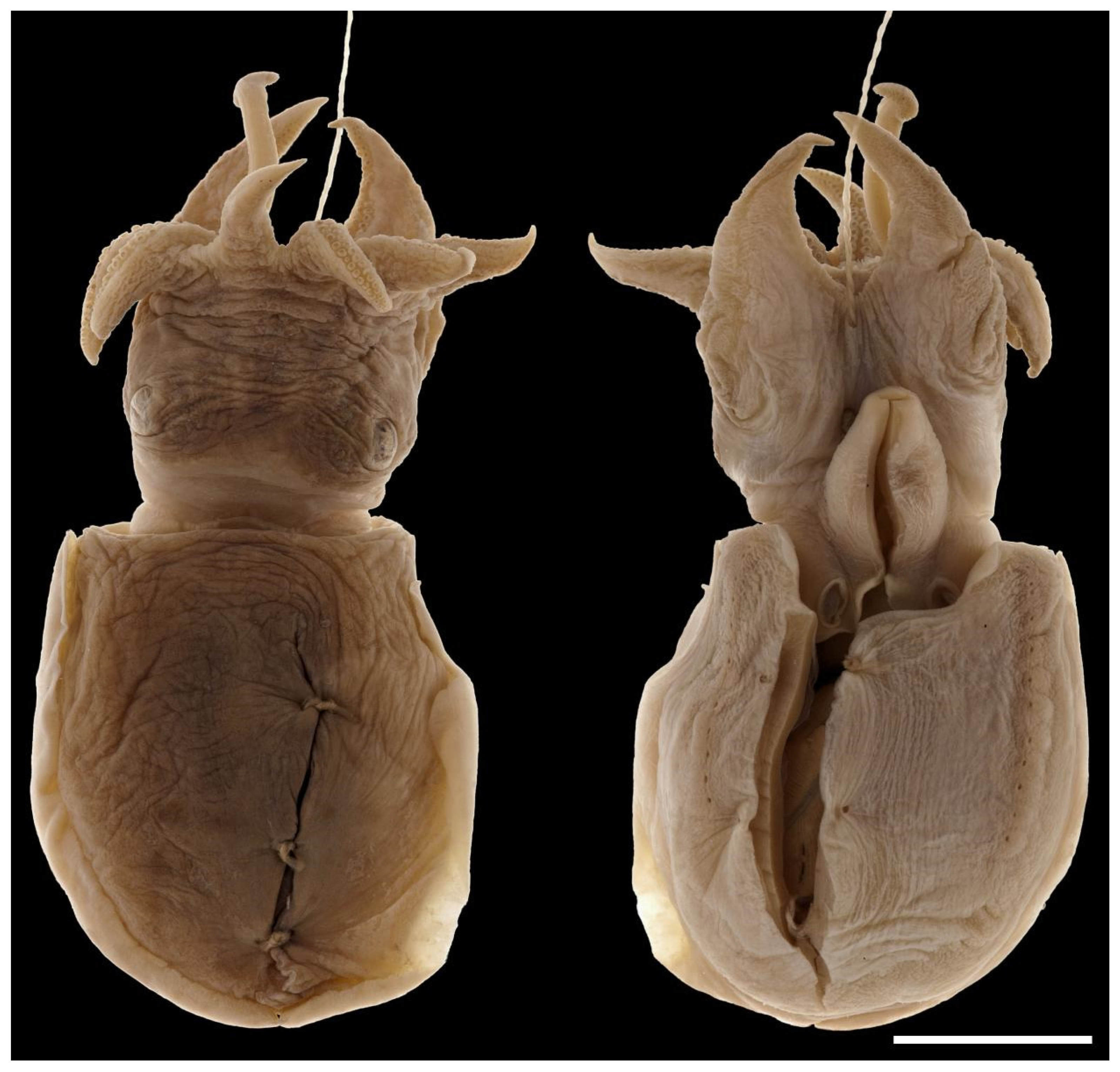
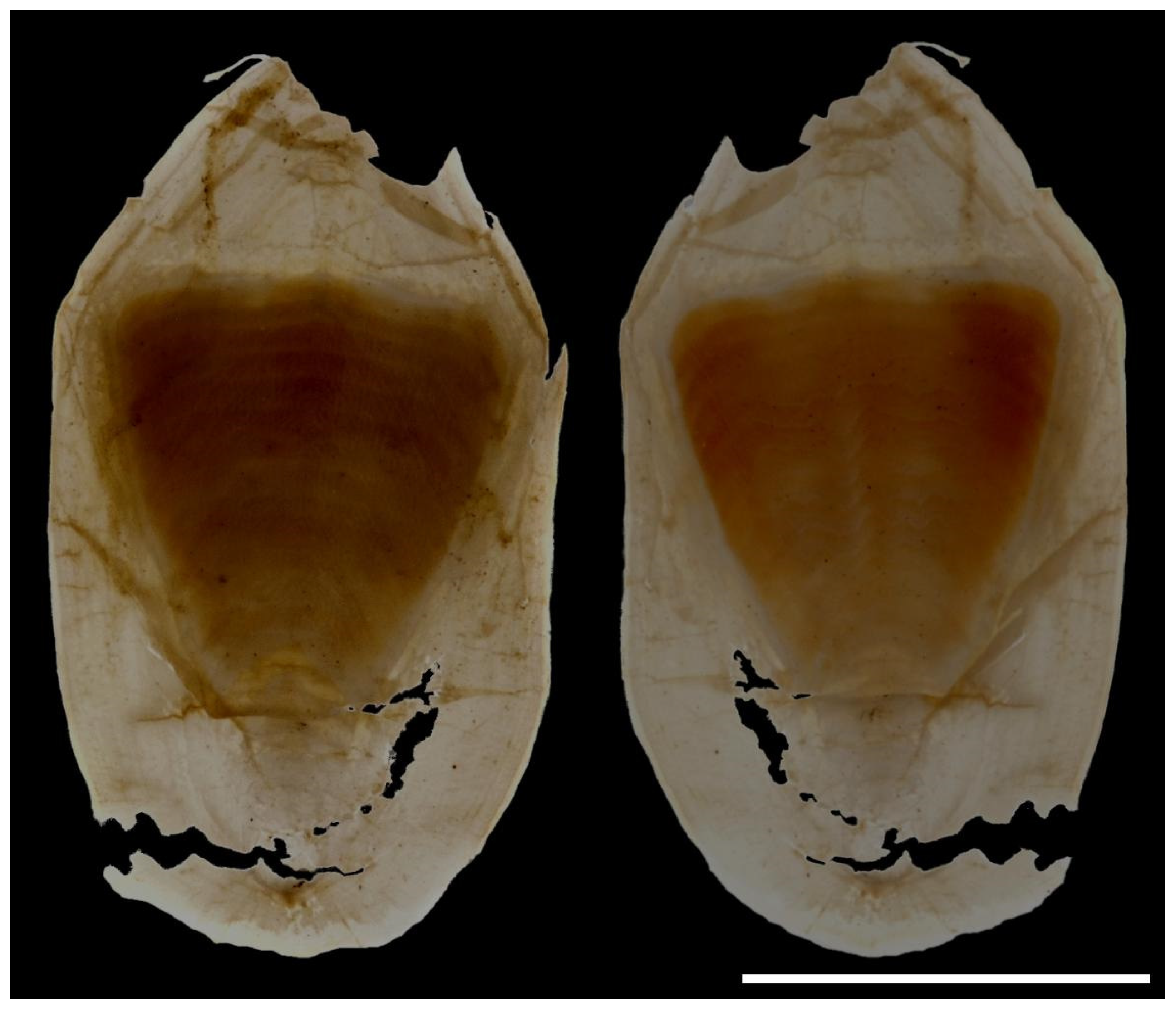

References
- Roeleveld, M.A.; Liltved, W.R. A new species of Sepia (Cephalopoda, Sepiidae) from South Africa. Ann. S. Afr. Mus. 1985, 96, 1–18. [Google Scholar]
- Lipinski, M.R.; Leslie, R.W. A new species of Sepia (Cephalopoda: Sepiidae) from South African waters with a re-description of Sepia dubia Adam et Rees, 1966. Folia Malacol. 2018, 26, 125–147. [Google Scholar] [CrossRef]
- Lipinski, M.R. Redescriptions of two species of Sepia (Cephalopoda: Sepiidae) from South African waters: Sepia robsoni (Massy, 1927) and S. faurei Roeleveld, 1972. Folia Malacol. 2020, 28, 253–285. [Google Scholar] [CrossRef]
- Lipinski, M.R. Two new species of Sepia Linnaeus, 1758 (Cephalopoda: Sepiidae) from South African waters. Folia Malacol. 2020, 28, 175–200. [Google Scholar] [CrossRef]
- Chun, C. Die Cephalopoden. II. Teil: Myopsida, Octopoda. Wiss. Ergebn. dt. Tiefsee-Exped. “Valdivia” 1915, 18, 405–552. [Google Scholar]
- Thore, S. On the Cephalopoda of Prof. O. Carlgren’s expedition to South Africa in 1935. K. Fysiog. Sällsk. Lund Förh. 1945, 15, 49–57. [Google Scholar]
- Adam, W.; Rees, W.J. A review of the cephalopod family Sepiidae. Scient. Rep. John Murray Exped. 1966, 11, pls-1. [Google Scholar]
- Roeleveld, M.A. A Review of the Sepiidae (Cephalopoda) of Southern Africa. Ann. S. Afr. Mus. 1972, 59, 193–313, plates 35–45. [Google Scholar]
- Lipinski, M.R.; Underhill, L.G. Sexual maturation in squid: Quantum or continuum? S. Afr. J. Mar. Sci. 1995, 15, 207–223. [Google Scholar] [CrossRef] [Green Version]
- Winterbottom, R.; Reist, J.D.; Goodchild, C.D. Geographic variation in Congrogadus subducens (Teleostei, Perciformes, Congrogadidae). Can. J. Zool. 1984, 62, 1605–1617. [Google Scholar] [CrossRef]
- Reid, A. Taxonomic review of the Australian Rossiinae (Cephalopoda: Sepiolidae), with a description of a new species, Neorossia leptodons, and a redescription of N. caroli (Joubin, 1902). Bull. Mar. Sci. 1991, 49, 748–831. [Google Scholar]
- Oksanen, J.; Simpson, G.; Blanchet, F.; Kindt, R.; Legendre, P.; Minchin, P.; O’Hara, R.; Solymos, P.; Stevens, M.; Szoecs, E.; et al. Vegan: Community Ecology Package. R package Version 2.6-4. Available online: https://CRAN.R-project.org/package=vegan (accessed on 15 November 2022).
- Anderson, M.J. A new method for non-parametric multivariate analysis of variance. Austral Ecol. 2001, 26, 32–46. [Google Scholar]
- Martinez Arbizu, P. PairwiseAdonis: Pairwise multilevel comparison using adonis. R package version 0.0.1. 2017. Available online: https://github.com/pmartinezarbizu/pairwiseAdonis (accessed on 15 November 2022).
- Dufrene, M.; Legendre, P. Species assemblages and indicator species: The need for a flexible asymmetrical approach. Ecol. Monogr. 1997, 67, 345–366. [Google Scholar] [CrossRef]
- Steenstrup, J. Hemisepius, en ny slaegt of Sepia-Bläcksprutternes Familie, Bemaerkinger om Sepia-Formerne i Almindelighed. K. Danske Vidensk. Selsk. Skr. 1875, 10, 465–482. [Google Scholar]
- Hoyle, W.E. Report on the Cephalopoda collected by HMS Challenger during the years 1873–1876. Rep. Voy. Challenger 1873–76. 1886, 16, 1–245. [Google Scholar]
- Hoyle, W.E. The Cephalopoda of the Scottish National Antarctic Expedition. Trans. R. Soc. Edinb. 1912, 48, 273–283. [Google Scholar] [CrossRef]
- Smith, E.A. A list of species of Mollusca from South Africa, forming an appendix to G. B. Sowerby’s “Marine shells of South Africa”. Proc. Malac. Soc. Lond. 1903, 5, 354–402. [Google Scholar]
- Smith, E.A. On the shells of the South African species of Sepiidae. Proc. Malac. Soc. Lond. 1916, 12, 20–26. [Google Scholar]
- Massy, A.L. The Cephalopoda of the South African Museum. Ann. S. Afr. Mus. 1927, 25, 151–167. [Google Scholar]
- Voss, G.L. South African cephalopods. Trans. R. Soc. S. Afr. 1962, 36, 245–272. [Google Scholar] [CrossRef]
- Voss, G.L. Some batyhpelagic cephalopods from South African waters. Ann. S. Afr. Mus. 1967, 50, 61–88. [Google Scholar]
- de Rochebrune, A.T. Étude monographique de la famille des Sediadae. Bull. Soc. philomath. Paris (7) 1884, 8, 74–122. [Google Scholar]
- Roeleveld, M.A. A revision of Massy’s checklists of “South African” cephalopoda. Ann. S. Afr. Mus. 1975, 66, 233–255. [Google Scholar]
- Roeleveld, M.A.C. The status and importance of cephalopod systematics in southern Africa. S. Afr. J. Mar. Sci. 1998, 20, 1–16. [Google Scholar] [CrossRef] [Green Version]
- Khromov, D.N. Taxonomic keys. In Systematics and Biogeography of Cephalopods Vol I; Voss, N.A., Vecchione, M., Toll, R.B., Sweeney, M.J., Eds.; Smithson. Contrib. Zool.; Smithsonian Institution Press: Washington, DC, USA, 1998; Volume 586, pp. 140–156. [Google Scholar]
- Khromov, D.N.; Lu, C.C.; Guerra, A.; Dong, Z.H.; Boletzky, S.V. A synopsis of sepiidae outside Australian waters (Cephalopoda: Sepioidea). In Systematics and Biogeography of Cephalopods. Vol I; Voss, N.A., Vecchione, M., Toll, R.B., Sweeney, M.J., Eds.; Smithson. Contrib. Zool.; Smithsonian Institution Press: Washington, DC, USA, 1998; pp. 77–139. [Google Scholar]
- Reid, A.; Jereb, P.; Roper, C.F.E. Family Sepiidae. In Cephalopods of the World. An Annotated and Illustrated Catalogue of Species Known to Date; Jereb, P., Roper, C.F.E., Eds.; Volume 1. Chambered nautiluses and sepioids (Nautilidae, Sepiidae, Sepiolidae, Sepiadariidae, Idiosepiidae and Spirulidae); FAO Species Catalogue for Fishery Purposes. No. 4; FAO: Rome, Italy, 2005; Volume 1, pp. 57–152. [Google Scholar]
- Leslie, R.W.; Lipinski, M.R. Phylum Mollusca–Class Cephalopoda. In Field Guide to the Offshore Marine Invertebrates of South Africa; Atkinson, L.J., Sink, K.J., Eds.; Malachite Marketing and Media: Pretoria, South Africa, 2018; pp. 321–391. [Google Scholar]
- Bonnaud, L.; Lu, C.C.; Boucher-Rodoni, R. Morphological character evolution and molecular trees in sepiids (Mollusca: Cephalopoda): Is the cuttlebone a robust phylogenetic marker? Biol. J. Linn. Soc. 2006, 89, 139–150. [Google Scholar] [CrossRef]
- Neige, P. The geography of body size in cuttlefishes (Cephalopoda, Sepiidae). Swiss J. Paleontol. 2021, 140, 1–16. [Google Scholar] [CrossRef]




Publisher’s Note: MDPI stays neutral with regard to jurisdictional claims in published maps and institutional affiliations. |
© 2022 by the authors. Licensee MDPI, Basel, Switzerland. This article is an open access article distributed under the terms and conditions of the Creative Commons Attribution (CC BY) license (https://creativecommons.org/licenses/by/4.0/).
Share and Cite
Leslie, R.W.; Richardson, A.J.; Lipiński, M.R. Detailed Description and Morphological Assessment of Sepia typica (Steenstrup, 1875) (Cephalopoda: Sepiidae). Diversity 2022, 14, 1073. https://doi.org/10.3390/d14121073
Leslie RW, Richardson AJ, Lipiński MR. Detailed Description and Morphological Assessment of Sepia typica (Steenstrup, 1875) (Cephalopoda: Sepiidae). Diversity. 2022; 14(12):1073. https://doi.org/10.3390/d14121073
Chicago/Turabian StyleLeslie, Robin W., Anthony J. Richardson, and Marek R. Lipiński. 2022. "Detailed Description and Morphological Assessment of Sepia typica (Steenstrup, 1875) (Cephalopoda: Sepiidae)" Diversity 14, no. 12: 1073. https://doi.org/10.3390/d14121073
APA StyleLeslie, R. W., Richardson, A. J., & Lipiński, M. R. (2022). Detailed Description and Morphological Assessment of Sepia typica (Steenstrup, 1875) (Cephalopoda: Sepiidae). Diversity, 14(12), 1073. https://doi.org/10.3390/d14121073







